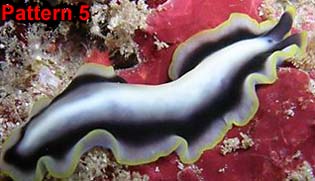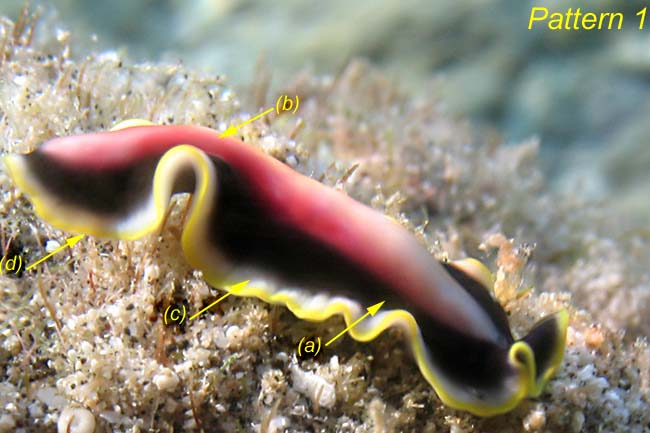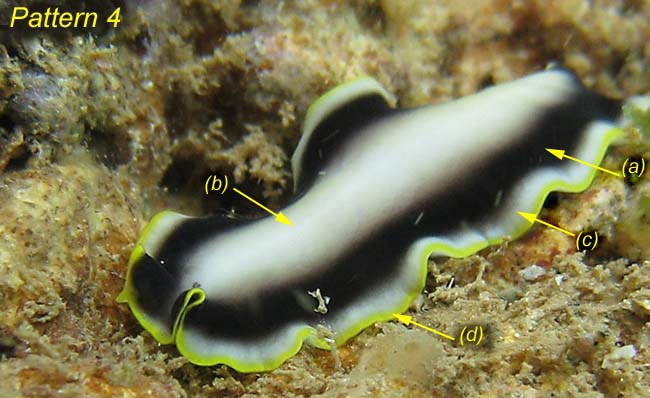This species has been observed on Reunion, Mauritius, Mayotte and Madagascar Islands
Background body colour white, cream, yellowish or orange, grey-black near the margin Marginal band wide, white to cream Rim narrow, yellowish to bright yellow |

|
|
| Showing species characteristics... | Photo Christophe Cadet |
|
See more about : Pseudoceros jebborum and paralaticlavus variability in Southwest Indian ocean
Remarks :
Pseudoceros jebborum and P. paralaticlavus are identified from Reunion Island specimens by Leslie Newman (2003), but unfortunately only a photo of P. jebborum illustrated its publication... So we are sure that these two species are present in our area
These two species have a very similar and variable pattern, so it is very difficult even impossible to separate only with photo these two species. Only a DNA analysis can help to differentiate between these two species : the nucleotide sequence ITS1 ( Internal Transcribed Spacer 1) in the ribosomal RNA gene cluster of P. paralaticlavus differs by 6% (24/421 positions) from that of P. jebborum. (Goggin and Newman, 1996)
|
|
 |
 |
 |
 |
 |
Bibliographic data :
Leslie Newman description of these two species :
Pseudoceros jebborum
Pseudoceros paralaticlavus
Ethymology :
- after Dr Jebb and the Jebb familyEthymology :
-para=like, lati=broad, clavus=stripe; similar to P. laticlavusDescription :
- Background body colour cream-orange, grey-black near margin.
- Marginal band wide, cream.
- Rim yellow.
- Size : 70 mmDescription :
- Background colour black with a wide cream-white median stripe.
- Marginal band wide, white.
- Rim narrow, bright yellow.
- Size : 50 mmHabitat :
- Found on the reef slope under rubbleHabitat :
- Found on the reef crest under rubble, feeding on yellow colonial ascidiansDistribution :
- Indo West Pacifique including Reunion IslandDistribution :
- Indo West Pacifique including Reunion Island and South Africa
Others pattern variations described in differents publications.
- Presence of a narrow median white stripe on the median longitudinal white-cream band.
- Sometimes the folds of the pharynx show a dark purple color.
The same color pattern is present on the ventral side but sometimes the folds of the pharynx show a dark purple color.
Pseudotentacles formed by simple folds of the margin with few pseudotentacular eyes. A small cerebral cluster contents about 30-60 eye spots
In mature specimens the oviducts and ovaries are red-purple
References :
Discover life : Pseudoceros jebborum and Pseudoceros paralaticlacus
Nudipixel : Pseudoceros paralaticlavus
Publications :
Goggin, C.L. and Newman, L.J. (1996). Use of molecular data to discriminate pseudocerotid turbellarians. Journal of Helminthology. Cambridge University Press 70:123-126
Newman, L.J. & Cannon, L.R.G. (1994). Biodiversity of Australian polyclad flatworms. Memoirs of the Queensland Museum 36: 159–163
Newman, L.J. & Cannon, L.R.G. (1998). Pseudoceros (Platyhelminthes, Polycladida) from the Indo-Pacific with twelve new species from Australia and Papua New Guinea. The Raffles Bulletin of Zoology 46: 293–323
Newman, L.J. & Cannon, L.R.G. (2003). Marine Flatworms: the world of Polyclads. CSIRO Publishing : Melbourne 112
Other photos of Pseudoceros jebborum and paralaticlavus :
Pattern 1 - Background colour black (a) with a wide Philibert Bidgrain Reunion, Grand fond Lagoon, Saint Gilles, less 1 m, 26 March 2010, size : 25 mm |
 |
 |
Olivier Police Mayotte, "Platier des badamiers", Petite Terre, less 1 m, 31 December 2009. The same patern with a fade pinkish coloration
|
Pattern 2 - Background colour black (a) with a wide Marina Poddubetskaia Reunion, "Banc de sable", Saint Leu, 16 m, 9 October 2002, size : 70 mm Leslie Newman considered this specimen as a form of Pseudoceros jebborum in its CDrom. Marine Flatworms: the world of Polyclads (2003) |
 |
 |
Underside view : The same color pattern is present on the ventral side but sometimes the folds of the pharynx (a) show a dark purple color.
|
Pattern 3 - Background colour black (a) with a wide Philibert Bidgrain Reunion, Grand fond Lagoon, Saint Gilles, less 1 m, 26 October 2010, size : 25 mm |
 |
 |
Philibert Bidgrain Reunion, Trou d'eau, less 1 m, 15 March 2010, size : 10-12 mm A small specimen...
|
Jean-Marie Gradot Mauritius, Blue bay, less 1 m, 15 January 2016, size : 40 mm
|
 |
Pattern 4 - Background colour black (a) with a wide Matthias Deuss Mayotte, 31 December 2009. |
 |
 |
Christophe Cadet Reunion, Etang salé lagoon, less 1 m, 29 October 2010, size : 15 mm
|
Pattern 5 - Background colour black (a) with a wide Philibert Bidgrain Reunion, 1 February 2005 |
 |
More photos from Indian Ocean
See more about : Pseudoceros jebborum and paralaticlavus variability in Southwest Indian ocean
Madagascar, Pseudoceros jebborum/paralaticlavus type 4, at Nosy bé, by Nathalie Bazard